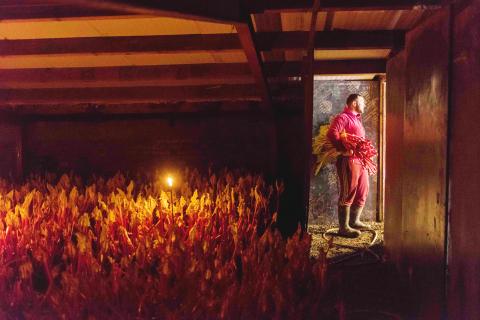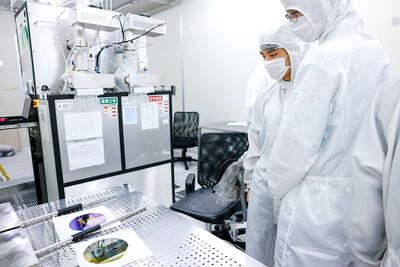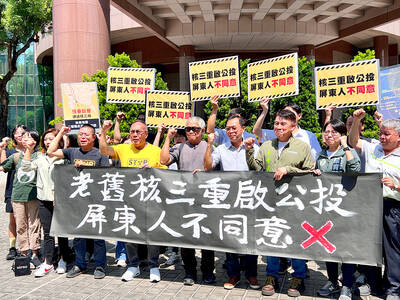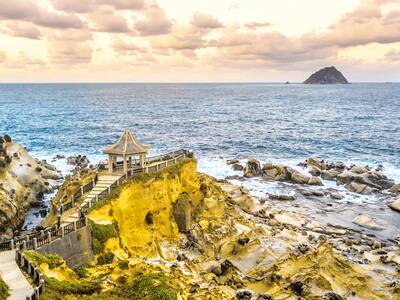It is rhubarb harvest season in the candle-lit sheds of northern England, where farmers are cashing in on a new trend for the vegetable in modern British cuisine.
Farmers in the “Rhubarb Triangle,” whose points traditionally are the industrial Yorkshire cities of Bradford, Wakefield and Leeds, have been growing the plant the same way for over a century.
“There’s no way of improving, we grow it almost exactly the same way as we did 100 years ago, there’s no other way to do it,” Robert Tomlinson, a fourth-generation rhubarb farmer, said.

Photo: AFP
Rhubarb is initially planted outside, where they grow slowly for two years in Yorkshire’s wet and cold soils before being taken into heated sheds in the autumn.
The purple stems then grow at a rapid rate, using the energy stored up during their time outside, and are picked in late winter.
“At certain times in the shed, you can hear it creaking and groaning because it grows that fast, it can grow six or seven inches in three or four days,” said Tomlinson, whose farm is one of four in the region with protected designation of origin status for specialty produce.
The process, known as “forcing,” was developed in the late 1800s after the plant was initially brought over from Siberia for its purported medicinal qualities.
It then graced dinner tables for generations in a dessert known as rhubarb crumble, traditionally served with custard.
But a new generation of chefs were drawn to its deep red color and sharp flavor, combining it in savory and sweet dishes, and even making rhubarb champagne.
“It’s got its own unique flavor, it’s like nothing else,” said Tomlinson.
“It did go out of fashion but people are realizing it’s not just crumble now, you can use it with all sorts of stuff,” he added, saying it paired particularly well with “mackerel, venison, or any oily fish.”
He credited more colorful and less acidic varieties developed in the 1960s for the plant’s resurgence.
“Over the last 10 years, demand has increased massively,” he said, explaining that he regularly ships the product to restaurants in Switzerland and New York.

The low voter turnout for the referendum on Aug. 23 shows that many Taiwanese are apathetic about nuclear energy, but there are long-term energy stakes involved that the public needs to grasp Taiwan faces an energy trilemma: soaring AI-driven demand, pressure to cut carbon and reliance on fragile fuel imports. But the nuclear referendum on Aug. 23 showed how little this registered with voters, many of whom neither see the long game nor grasp the stakes. Volunteer referendum worker Vivian Chen (陳薇安) put it bluntly: “I’ve seen many people asking what they’re voting for when they arrive to vote. They cast their vote without even doing any research.” Imagine Taiwanese voters invited to a poker table. The bet looked simple — yes or no — yet most never showed. More than two-thirds of those

In the run-up to the referendum on re-opening Pingtung County’s Ma-anshan Nuclear Power Plant last month, the media inundated us with explainers. A favorite factoid of the international media, endlessly recycled, was that Taiwan has no energy reserves for a blockade, thus necessitating re-opening the nuclear plants. As presented by the Chinese-language CommonWealth Magazine, it runs: “According to the US Department of Commerce International Trade Administration, 97.73 percent of Taiwan’s energy is imported, and estimates are that Taiwan has only 11 days of reserves available in the event of a blockade.” This factoid is not an outright lie — that

Former Chinese Nationalist Party (KMT) chairwoman Hung Hsiu-chu’s (洪秀柱) attendance at the Chinese Communist Party’s (CPP) “Chinese People’s War of Resistance Against Japanese Aggression and the World Anti-Fascist War” parade in Beijing is infuriating, embarrassing and insulting to nearly everyone in Taiwan, and Taiwan’s friends and allies. She is also ripping off bandages and pouring salt into old wounds. In the process she managed to tie both the KMT and the Democratic Progressive Party (DPP) into uncomfortable knots. The KMT continues to honor their heroic fighters, who defended China against the invading Japanese Empire, which inflicted unimaginable horrors on the

Sitting on a bus bound for Heping Island (和平島), at the start of my first visit to Keelung in years, I was hell-bent on visiting a place of considerable historical interest, even though I knew that it wasn’t officially open to the public. In 2011, archaeologists working in the densely populated southern half of the island unearthed the foundations of the Convento de Todos los Santos (Convent of All Saints, 諸聖教堂), a Catholic house of worship established during Spain’s 1624-1642 occupation of northern Taiwan. I’d heard about its rediscovery a while ago, but it wasn’t until I read a scholarly